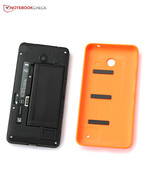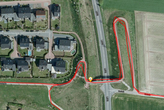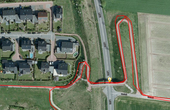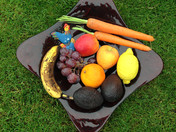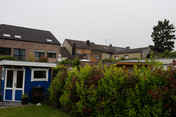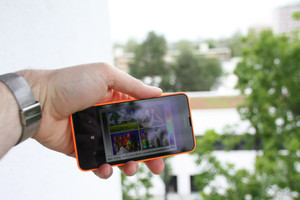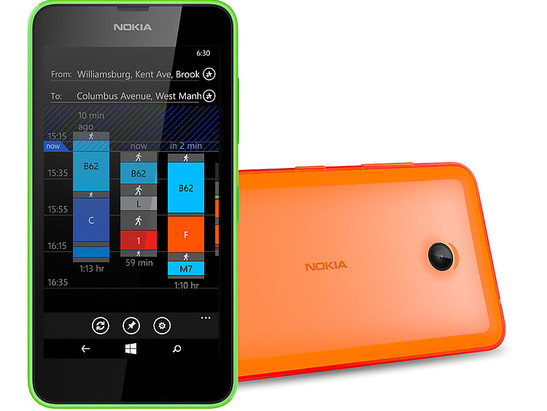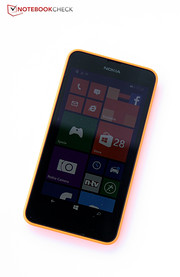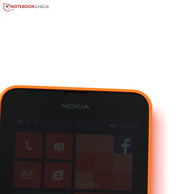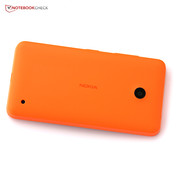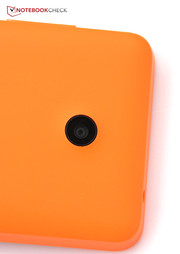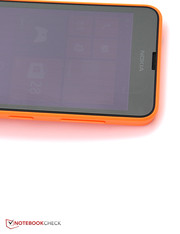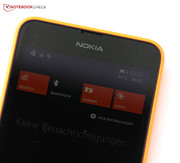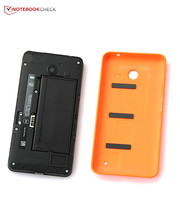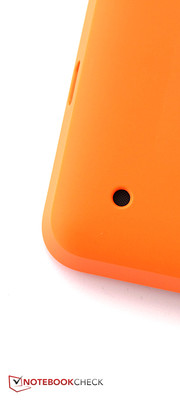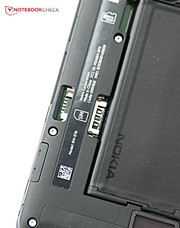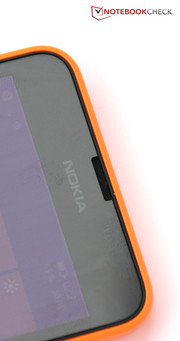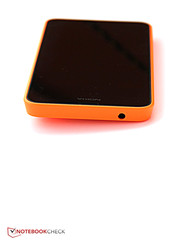Nokia Lumia 630 Smartphone Review
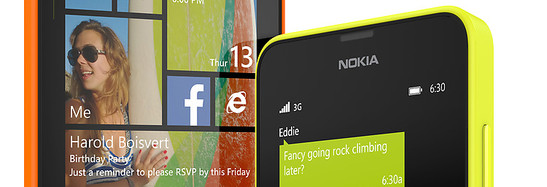
For the original German review, see here.
Nokia's Lumia 630 featuring Windows Phone 8.1 is the first review sample to find its way into our lab. The successor of Nokia's Lumia 620 is categorized as an affordable device for below 200 Euros (~$271), and its price design is to attract both young people and customers with a tighter budget. This time, Nokia, or better said its new owner Microsoft, has expanded its model line and also offers a dual-SIM model as well as an LTE-phone with the Lumia 635.
However, our Lumia 630 can only be classically furnished with a sole SIM card, but it supports micro-SD cards to expand its somewhat tight 8 GB of storage.
Devices like the Motorola Moto E, Nokia X, Acer Liquid Z5, HP Slate 6 6000en, Samsung Galaxy S Duos 2, Motorola Moto G or Kazam Thunder Q4.5 are found in the below-200-Euros (~$271) price range - and thus many Android phones compete against the Lumia 630. Even the former premium generation of Windows Phones, such as Samsung's Ativ S that can also be upgraded to Windows Phone 8.1, are now available for 50 Euros (~$67) more.
Case
Do you still remember Nokia's 3210? Not only did it debut T9, but the owner also had various "Xpress-on-Covers" that allowed custom-designing the phone in a drawer at home. Nokia revives this over 15-years-old idea. The back cover is easy to remove and replace with another one. This also facilitates accessing the removable battery, SIM card, and micro-SD card.
Naturally, flashy colors are again available for the back cover that also envelops the display on the front. We received a striking orange cover for our review sample. Orange, yellow, green and business-like white or black are also available. Many third-party manufacturers were quick to offer covers for the Lumia 620, and similar accessories will also likely soon follow for the Lumia 630.
We really liked the quality of the precursor's casing, and the Lumia 630 is also compelling. Despite its swappable back cover, it makes a very compact impression and is nice to hold. The back side of Nokia's cover is slightly roughened so that the smartphone does not easily slip out of the hand. However, the Lumia 630 only resists pressure on the front to a certain extent despite the Gorilla Glass 3, and waves and color distortions are instantly seen on the screen. We also noticed quiet creaking noises.
Since the screen has grown to 4.5-inches, the casing is also slightly bigger than that of its precursor. However, some space could be saved by placing the touch buttons on the screen (an innovation of Windows Phone 8.1).
Connectivity
Compared with the Lumia 620, only the processor's clock has been increased by 0.2 GHz. The RAM capacity, graphics unit, and storage size have not been modified. The interfaces have also been left untouched. One micro-USB 2.0 port, and a 3.5 mm audio jack for a headset are today's standard for most smartphones. The micro-SD card reader, however, now supports up to 128 GB. The camera button has been omitted; Microsoft no longer demands this, and pictures can now only be taken via tapping on the screen or by creating the corresponding icon.
Software
The operating system has been modified to quite an extent. Windows Phone Version 8.1 is responsible for that, and an update is also available for other Lumia smartphones powered by Windows Phone 8. Microsoft's update involves far-reaching innovations that are intended to make the operating system more similar with Android and iOS. Both latter operating systems have a clear lead in terms of market share.
One of the most significant innovations is the message center that, like Android, is opened by swiping across the screen's upper edge, and it displays all recent emails, messages, calls, etc. as a short message. Besides that, quick accesses, such as flight mode or brightness, can be defined via the settings. Though this is not yet as comfortable to manage as in Android, it is a clear improvement. The smartphone can be customized even more by defining a background image for the home screen instead of using the contrast color. However, too small-scale backgrounds complicate the overview, but that is no different in Android or iOS. Icons can now also be arranged in six columns on smaller screens rather than in four. All apps are now listed alphabetically, and the calendar is more clearly arranged and has its own app.
Even smaller modifications are very pleasant, for example, tapping a contact leads to immediate calling rather than displaying contact details. Overall, Windows Phone 8.1 can be used very comfortably and has become more intuitive and logical. The countless innovations include a lot of things that users missed in Windows Phone 8. Nokia also offers a few additional settings, such as color temperature and saturation for the screen, and blocking specified callers.
Nokia installs a few software treats and again free apps are pre-loaded: Nokia MixRadio sets up a music program from the user's preferences, AppSocial arranges the Windows Phone Store more clearly, and HereDrive+ allows navigating with offline maps for free, when desired.
Communication & GPS
The communication modules are also largely the same. Wi-Fi standard 802.11 b/g/n is still used. The Wi-Fi display of Windows Phone 8.1, unfortunately, does not respond to changes in signal strength as, for example, Android. Nevertheless, we still measured half the signal strength at a distance of ten meters to the router and through three walls. That roughly corresponds to the reception quality of other smartphones. The mobile network reception is also good; we almost always had full reception in the Telecom network in a radius of 300 meters in an urban environment.
Users can choose among American GPS, Russian Glonass or Chinese BeiDou as the satellite tracking system. We also liked the system's accuracy. We recorded a longitude data deviation of only 40 meters between the Garmin Edge 500 navigation system and the Lumia 630 on our test route. The Lumia 630 was just as accurate when crossing a bridge as it was in the woods.
Telephony & Speech Quality
The phone features have been redesigned and expanded in Windows Phone 8.1. A call can now instantaneously be redirected to Skype to turn it into a video call; calls are made by tapping on the corresponding icon, and the caller's picture takes up more surface area. Overall, this app is also a bit more intuitive and extensive although the modifications are not fundamental.
The speech quality is decent. The caller is heard loud and clearly, though the sound is a bit tinny compared with higher-quality smartphones. The hands-free mode via the speaker is satisfactory; the caller could be understood and still heard us even when we stood further away from the microphone.
Cameras & Multimedia
The Lumia 620 featured a front-facing camera, even if only with the VGA resolution of 640x480 pixels. Nokia completely omitted it this time, just like the LED flash on the back. The rear-facing camera's technical specs are the same as in Nokia's Lumia 620: 5 megapixels, 1/4-inch lens, focal length of 28 mm, and aperture of 2.4. Decent pictures can be shot in bright light conditions. The automatic white balance tends to drift into blue, but it can be set manually in Nokia's comprehensive camera app. The pictures are relatively high in detail and focused, and they can compete with other smartphone cameras.
The camera even brightens shots decently in weak light but exhibits color noise here. Since there is no flash, the camera soon finds its limits in very dark rooms.
Accessories
The charger has a non-removable cord and thus a micro-USB cable would either have to be available or purchased when connecting Nokia's Lumia 630 to a computer. This is also a saving measure compared with the precursor.
Nokia has a lot of colorful accessories in its range that don't only fit for the Lumia 630: For example, a mini-Bluetooth speaker with an unknown price at the time of writing, or a few portable charging plates that can be put in jacket pockets or handbags for recharging the phone on the go. The DC-19 is available for around 25 Euros (~$33), and the DC-18 for approximately 12 Euros (~$16). Besides that, various headphones are also found among the optional accessories.
Warranty
Nokia includes a 24-month warranty on the smartphone and six months on the battery and charger. After repair, the phone is still at least covered for 60 days, even if it goes beyond the actual warranty period.
Input Devices & Controls
It is not at all annoying that the controls for search, home, and back are now displayed on the screen due to its significantly larger size compared with the precursor, and the narrow navigation bar. The omitted camera button that allowed opening the camera even from standby is more painful.
Windows Phone 8.1 responds swiftly and without noticeable lags to our inputs on the Lumia 630. The touchscreen is also still reliable in the corners, and the screen's finish is very slick. Multi-touch gestures, such as zoom or rotate, are implemented reliably.
Display
Though the screen's size has increased compared with Nokia's Lumia 620, the resolution of 854x480 pixels is virtually identical. The pixel grid is particularly visible during movements due to the even lower dpi count. Colors look a bit pale at first but also quite natural. Users can increase the saturation via software when desired.
The screen's brightness is considerably lower compared with Nokia's Lumia 620. The screen in the Lumia 630 only shines with 350 cd/m². The precursor achieved 502.1 cd/m². That was, of course, also one of the highest rates that we had ever measured in a smartphone, and thus the brightness of Nokia's Lumia 630 is more midfield compared with other phones. The illumination of 91% is still relatively even but also a bit less homogeneous then that of Nokia's Lumia 620.
| |||||||||||||||||||||||||
Brightness Distribution: 91 %
Center on Battery: 355 cd/m²
Contrast: 486:1 (Black: 0.73 cd/m²)
ΔE ColorChecker Calman: 7.19 | ∀{0.5-29.43 Ø4.79}
ΔE Greyscale Calman: 5.63 | ∀{0.09-98 Ø5}
Gamma: 1.97
CCT: 6293 K
Nokia's Lumia 630 also has to accept losses in terms of black level and contrast when compared to its precursor. The black level has increased to 0.73 cd/m², and that alongside the low brightness leads to a lower contrast of 486:1. Consequently, the phone not only lags behind the Lumia 620 but also behind Motorola's Moto E and HTC's 8S.
A few unpleasant rates were ascertained in the measurements using CalMAN software and the colorimeter. For example, pure white is considerably far from the ideal value and is more a pale mint green. Besides that, the red hues strongly deviate from their ideal rate. However, to be fair, we have to mention that Nokia offers quite extensive color temperature and saturation options in the settings for improving the image.
The successor cannot compete with the good outdoor suitability of the Lumia 620. It is usually possible to recognize screen content fairly well on cloudy days, but it becomes difficult on sunny days. Problems should not be encountered indoors or in the shade.
Performance
The SoC has been upgraded: The Lumia 620 now sports a Qualcomm Snapdragon 400 MSM8226 with 1.2 GHz of processing power. Thus, the processor is 0.2 GHz faster than the Lumia 620, and it is a quad-core processor. However, the working memory has not changed. 512 MB of RAM is the limiting factor for some apps that are then not even listed in the Store from the outset (for example, GFXBench or a few games). Nor has the graphics solution been replaced, but the Adreno 305 is enough for many apps and games.
Due to the lack of benchmarks in the Store, and the RAM-related limitation, we could only perform browser-based benchmarks. In total, Nokia's Lumia 630 is slightly superior to its precursor but clearly lags behind the just as inexpensive bargains from the Android sector, such as Motorola's Moto E or Samsung's Galaxy S Duos.
We did not ascertain any lags in navigation during practical use. Since applications and games that require more than 512 MB of RAM are not offered for the phone in the Store, the apps and games that we tested did not exhibit any major stutters or lags. However, the selection of apps is noticeably limited.
| Sunspider - 1.0 Total Score (sort by value) | |
| Nokia Lumia 630 | |
| Nokia Lumia 620 | |
| Acer Liquid Z4 | |
| Samsung Galaxy S Duos 2 GT-S7582 | |
| HP Slate 6 6000en VoiceTab | |
| Browsermark - 2.1 (sort by value) | |
| Nokia Lumia 630 | |
| Motorola Moto E 1. Gen 2014 | |
| Mozilla Kraken 1.1 - Total (sort by value) | |
| Nokia Lumia 630 | |
| Motorola Moto E 1. Gen 2014 | |
| Samsung Galaxy S Duos 2 GT-S7582 | |
| HP Slate 6 6000en VoiceTab | |
| Kazam Thunder Q4.5 | |
| Octane V2 - Total Score (sort by value) | |
| Nokia Lumia 630 | |
| Motorola Moto E 1. Gen 2014 | |
| Samsung Galaxy S Duos 2 GT-S7582 | |
| HP Slate 6 6000en VoiceTab | |
| Kazam Thunder Q4.5 | |
| WebXPRT 2013 | |
| Overall (sort by value) | |
| Nokia Lumia 630 | |
| Nokia Lumia 620 | |
| Samsung Galaxy S Duos 2 GT-S7582 | |
| Kazam Thunder Q4.5 | |
| Photo Effects (sort by value) | |
| Nokia Lumia 630 | |
| Nokia Lumia 620 | |
| Samsung Galaxy S Duos 2 GT-S7582 | |
| Kazam Thunder Q4.5 | |
| Face Detection (sort by value) | |
| Nokia Lumia 630 | |
| Nokia Lumia 620 | |
| Samsung Galaxy S Duos 2 GT-S7582 | |
| Kazam Thunder Q4.5 | |
| Stocks Dashboard (sort by value) | |
| Nokia Lumia 630 | |
| Nokia Lumia 620 | |
| Samsung Galaxy S Duos 2 GT-S7582 | |
| Kazam Thunder Q4.5 | |
| Offline Notes (sort by value) | |
| Nokia Lumia 630 | |
| Nokia Lumia 620 | |
| Samsung Galaxy S Duos 2 GT-S7582 | |
| Kazam Thunder Q4.5 | |
* ... smaller is better
Emissions
System Noise
Nokia's Lumia 630 does not do as good a job as its precursor in temperature development either. That is due to the higher maximum temperature of 43.1 °C and the overall slightly higher average operating temperatures.
However, Nokia's Lumia 630 never heats up to such an extent that it can no longer be held, but its temperature is noticed during load. A temperature increase is already noticed in some areas when the Lumia 630 is idling; the Lumia 620 remained much cooler here. Samsung's Galaxy S Duos proves that lower temperatures are possible, with a maximum of 34.7 °C.
(±) The maximum temperature on the upper side is 43.1 °C / 110 F, compared to the average of 35.2 °C / 95 F, ranging from 21.9 to 247 °C for the class Smartphone.
(±) The bottom heats up to a maximum of 40.5 °C / 105 F, compared to the average of 34 °C / 93 F
(+) In idle usage, the average temperature for the upper side is 31.1 °C / 88 F, compared to the device average of 32.9 °C / 91 F.
Speakers
The rear-sided speaker has received a round hole in the back cover through which it can render its sound. However, it is noticed that the speaker is much bigger than this little recess suggests when the back cover is removed. It has an overall quite decent and loud sound, and it does not distort in maximum volume, although the sound is then only differentiated averagely. The sound is more precise when the volume is reduced slightly. Mids and trebles are fairly balanced, and low ranges are only hinted at.
Music can be enjoyed well via headphones. This time, there are no audio enhancements available.
Energy Management
Power Consumption
A topic where Nokia's Lumia 630 can clearly surpass its precursor: power consumption. The more modern and efficient SoC doubtlessly pays off here: Starting with the standby consumption of just 0.1 watts, over the evidently lower average idle consumption of 1.1 watts, up to the just as obviously decreased maximum consumption of 3.3 watts. Now Nokia's Lumia 630 is on par with Motorola's Moto E and Samsung's Galaxy S Duos in terms of power consumption.
| Off / Standby | |
| Idle | |
| Load |
|
Key:
min: | |
Battery Runtime
Nokia also treats the Lumia 630 to a larger battery: 6.8 watt hours in contrast to the precursor's 4.8 watt hours. This, alongside the considerably lower consumption rates, leads to a 4-hour longer runtime in the practical Wi-Fi test. The Lumia 630 lasted for 14:34 hours and thus even clearly beats Motorola's Moto E, Nokia's X and Acer's Liquid Z5.
Watching H.264 codec videos is also possible for over 12 hours, and the smartphone lasts for almost 16 hours when idling. Nokia's Lumia 630 makes a clear statement in this price range with that.
Verdict
Of course, Nokia's Lumia 630 has a considerably lower recommended price than the Lumia 620 had when it was launched on the market just over a year ago. The market has changed since then, and the prices for entry-level smartphones have dropped a notch. Consequently, Nokia has made cutbacks in many areas. The front-facing camera, LED flash, camera button, touch buttons, high screen brightness, micro-USB cord, NFC, and Dolby software are all victims of price pressure.
Those are quite a few restrictions, seeing that the precursor has become much cheaper, barely has more power (especially since the tight working memory is the limiting factor in both devices), and clearly leads in some areas like screen, camera, accessories, and temperatures. Windows Phone 8.1 is definitely not an argument because older devices can be updated with it.
So, what speaks for Nokia's Lumia 630? The quad-core SoC offers a bit more future security, and it consumes considerably less power than the SoC in the Lumia 620. The much larger battery makes great runtimes possible. Besides that, the larger screen is also appealing although the button bar on the screen puts this advantage back into perspective to an extent, and the resolution is not higher.
Buyers looking for an affordable Windows Phone are currently better served with the Lumia 620, particularly since it is now offered for virtually the same price as the Lumia 630. The Lumia 625 with LTE support is available for a bit more, or for an additional small surcharge even last year's premium Samsung ATIV S Windows Phone with considerably more working memory capacity, and thus the full selection of apps, is available.
The Lumia 630 is not really a bad bargain. However, in view of the company's own contenders we can only recommend it to users whose main focus is on long battery life.




